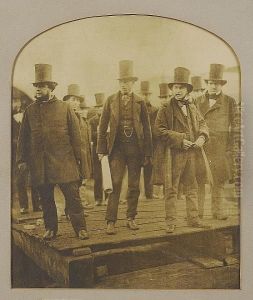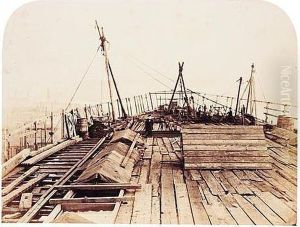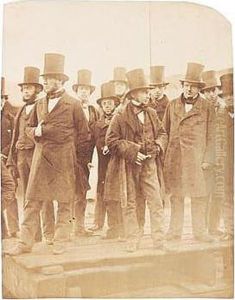Robert Howlett Paintings
Robert Howlett was a British photographer known for his significant contributions to the early development of photographic techniques and for capturing some of the most iconic images of the 19th century. Born in 1831 in Norfolk, England, Howlett was part of a generation that witnessed and participated in the rapid evolution of photography.
Howlett's interest in photography began in the 1850s, a period characterized by intense experimentation and innovation within the medium. He became particularly noted for his work in the wet collodion process, a method that involved coating glass with light-sensitive chemicals to create a negative image. This process, though it required a portable darkroom for immediate development, was a significant step forward in producing clearer, more detailed photographs.
One of Howlett's most famous photographs is the portrait of Isambard Kingdom Brunel, the celebrated Victorian engineer, standing in front of the launching chains of the Great Eastern steamship. Taken in 1857, this image has become emblematic of the industrial age and Brunel's towering presence within it. The portrait is revered not only for its subject matter but also for Howlett's skillful composition and use of lighting, which highlighted the grandeur of the engineering marvel and the stature of the man behind it.
Tragically, Howlett's career was cut short when he died at the young age of 27 in 1858, likely due to complications related to his exposure to the hazardous chemicals used in the photographic process. Despite his brief career, his contributions to the art and science of photography were profound. He left behind a body of work that continues to be studied and admired for its technical excellence and its capacity to convey the spirit of an era.
Howlett's work was exhibited during his lifetime, and his photographs were published in many of the leading journals of the day, spreading his influence and establishing his reputation as a leading photographer. Today, Howlett's photographs are held in collections around the world, including institutions such as the Victoria and Albert Museum in London and the National Portrait Gallery. His legacy is that of a pioneer who, through his mastery of the emerging art of photography, documented the monumental and the everyday, leaving a lasting impression on the visual record of Victorian Britain.



![The Great Eastern ['leviathan']](https://www.niceartgallery.com/imgs/679599/s/robert-howlett-the-great-eastern-leviathan-7bb69075.jpg)
